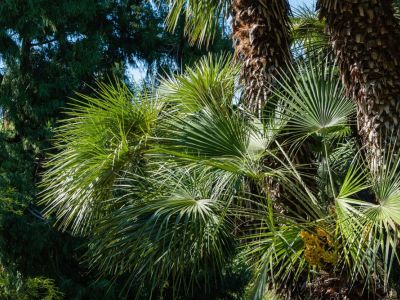Seed Propagating Windmill Palms
Every palm tree is different and their propagation methods and chances of success outside their native range will vary as well. Windmill palm propagation requires a male and a female plant to produce viable seeds. Short of lifting the plant’s skirts, it can be difficult to identify the plant’s gender without a professional. However, once blooming commences, the problem becomes more clear. Males develop huge yellow sweeping flower clusters that do not fruit, and females have smaller, greenish blooms that will develop into fruit. For successful windmill palm propagation, you need healthy ripe seed that is viable. Ripe seeds will come from drupes that are deeply bluish black and shaped a bit like a kidney bean. These will arrive on female plants approximately sometime in winter. You will need to clean off the pulp to get at the seeds. Most gardeners advocate the soaking method. Simply place seed in a bowl of warm water and let them soak for a couple of days. Then rinse off any pulp. You should now have fresh clean seed ready for propagating windmill palms. A good potting mix is 50 percent peat and 50 percent perlite. Pre-moisten the medium before you plant the seed. Once you have your seeds and your pre-moistened medium, it is time to plant. Fresh seed will germinate much more quickly and consistently than saved seed. Insert each seed to a depth of ½ inch (1 cm.) and cover lightly with the medium. Place a clear plastic bag over the flat or container. You are basically making a little greenhouse to contain moisture and encourage heat. Place the container in a dark area of the home that is at least 65 degrees F. (18 C.). Germination should occur in a month or two. If excess condensation builds up, remove the bag for an hour each day to prevent fungal development. Once the seedlings show, remove the bag entirely.
How to Propagate a Windmill Palm Tree from Cuttings
Growing palm trees from cuttings can be a faster way to get obvious plants with their typical characteristics, but it is not as assured as the seed method. However, if you have a palm and want to try it, look for any new growth at the base of the plant. This may occur if the trunk was damaged at some point. These are not true “pups” or “offshoots,” as some palms and cycads produce, but they may have sufficient new cell growth to produce a plant. Use a sterile, sharp knife to divide the growth away from the parent. Insert the cutting into the same half and half mixture listed above. Keep the soil moderately moist and the cutting in bright but indirect sunlight. With a little luck, the cutting may root and produce a new windmill palm.
